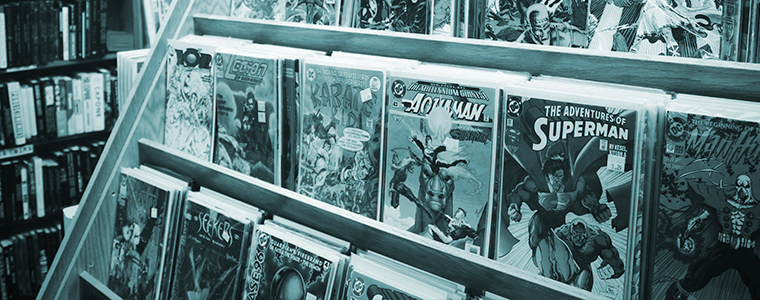Interview With Alecos Papadatos, Illustrator of the Graphic Novel Democracy
Conducted by R. S. Deese, Boston University, September 29, 2019
What comic-book characters and genres did you love as a kid, and what is your favorite memory of spending time with comics?
In the sixties and seventies in Greece, there was only Tin Tin, Asterix, and Disney. I loved them all. I started reading these comics even before being able to read the text in the balloons. I remember trying to imagine the sound of the letter “A”. “O” was easy to figure out.
Can you remember the first cartoons or comics that you drew yourself? If you shared them with others, what sort of reaction did you get?
I started copying my favorites on the back sheets of the school notebooks. Soon there was progress, schoolmates were excited, and I was the star of the class, along with the math champions. But the guy who pushed me into it was the least to want me into this career: my father. He showed me how to draw animation in the form of flip–books at the edge of the pages. I did it on a few of my textbooks, revealed to a couple of classmates, and then it became viral. Everybody asked me to fill their books with stick–figure animations with characters kicking and punching each other, planes transforming into flies, and so on. In the end, I started giving flip–book workshops. All the kids can draw, so everybody made his animation. The teachers got mad with “destroying the books with stupid doodles” and started distributing penalties.
When it comes to thinking about the medium of comics in a critical or theoretical way, are they any writers or artists whom you find to be especially persuasive or inspiring?
The main inspiration came from Robert Crumb, Charles Schulz, Carl Barks, Alex Toth, Jeff Smith and a few Europeans, like Hergé, Jean Giraud / Moebius, Loustal, Christophe Blain, Hugo Pratt, Blutch, Chabouté, Baudoin, Gipi. I cannot judge them as writers or artists, but they got a place in my heart with their ideas, their humanity, and their beautiful craftsmanship.
Both LOGICOMIX and DEMOCRACY shed light on major historical figures, exploring the time & place in which they lived. For this reason, some might categorize them as “educational comics.” What would your reaction be to that sort of categorization? If you had to put these comics in a category or genre, what would you call it?
A comics critic once called LOGICOMIX “stealth education”. Why not? But the leading writer of LOGICOMIX, Apostolos Doxiadis, is the one who best defined it: “Knowledge through Story”. That means an awful lot, but it is no way any “popularization” of science, history, etc. It has nothing to do with a publisher’s idea “let’s produce a series of biographies or science stuff in the form of graphic novel to enlarge our catalog”. I like history, among other subjects. The project is about a topic that speaks to my heart. It is exciting and challenging to turn it into a comic book, and I have the opportunity to share with the reader my knowledge and viewpoint on it. Bookstores want to categorize it as “non–fiction”, I would like to call it “fiction”, but who cares, it’s the making and the reading that counts after all.
In DEMOCRACY, the reformer Cleisthenes initiates a number of democratic reforms in Athens; which of these reforms do you believe had the greatest significance for the subsequent political and social history of ancient Athens?
Cleisthenes established peace and collaboration while giving power to all free men to decide on their fate. It had never happened before in history. His “Trittyes” project (it means “Thirds”), explained in detail in the comic, was decisive for not letting people fight each other. They were deciding together on everything. It was the basis for the development of the democratic system over the next century, called the “Golden Era” of ancient Athens.
Taking a longer view, which of Cleisthenes ideas or reforms might have the greatest relevance for democratic societies in the twenty-first century?
Free speech and Equality before the law for all citizens are the reforms that make the most sense to us.
When you set out to story of Cleisthenes and his reforms, what part of that story did you find especially suitable to the medium of comics, and what visual ideas did you develop to explore it?
While doing some research, I read books by Josiah Ober and a couple of French historians on the subject of the reforms. The “free speech and equality before the law” change was easy to show and tell. However, the “Trittyes” reform was complex. French use to say ironically, “You don’t have to draw it for me to understand it.” I decided that Leander, the protagonist, and narrator, draws a map of Athens for his comrades on the ground with a stick. Then he uses garlic cloves, tiny flowers, and pebbles to define the whole structure of it. They get it! So I hope the reader gets it, as well.
There’s an oft-cited quote from William Faulkner: “The past is never dead. It’s not even past.” As a modern Athenian, does this quote ring true to your own experience? What sights, sounds, or smells of your native city do the most to make you feel a connection to the ancient past that you describe in DEMOCRACY?
It’s the unique balance of the East–Mediterranean sunlight.
What is your next project related to Athenian history, and why is it exciting to you?
After DEMOCRACY, the Belgian publisher Dargaud proposed to work together. We are preparing a biography of Aristotle with a Greek writer, Tassos Apostolidis. It’s packed with lots of characters and many of the great man’s fascinating ideas.
